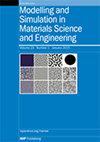Ti-6Al-4V合金薄片高速冲击CFRP靶材的动态损伤特性
IF 2.4
4区 材料科学
Q3 MATERIALS SCIENCE, MULTIDISCIPLINARY
Modelling and Simulation in Materials Science and Engineering
Pub Date : 2023-05-31
DOI:10.1088/1361-651X/acda4f
引用次数: 0
摘要
碳纤维增强塑料(CFRP)的发展使轻质防护材料行业发生了革命性的变化。在航空领域,了解CFRP在高速冲击下的损伤特性对于设计具有轻型风扇壳体的航空涡扇发动机至关重要。本研究使用了由TexGen创建的CFRP层压板的精细实体模型。利用ABAQUS/Explicit和VUMAT用户子程序模拟了CFRP层压板在冲击试验中的失效过程。该研究对实验期间记录的数据进行了详细分析,其中Ti-6Al-4V合金薄片使用轻气枪以156.9 m s−1至297 m s−2的速度撞击CFRP层压板。通过高速摄像机和3D-DIC进行的图像记录有助于识别宏观损伤特征,如CFRP层压板的形态和应变。通过动态应变时程曲线、扫描电子显微镜微观结构图像和损伤单元形态验证了数值模拟的可靠性。基体开裂、纤维拔出和分层等变形过程在吸收Ti-6Al-4V合金薄片的大部分初始动能方面起着至关重要的作用,从而保护层压板。鉴于我们的研究结果,结合弹道冲击的变形特性和能量吸收机制,提出了一种可靠的Ti-6Al-4V合金薄片穿透CFRP层压板损伤特性的数值模拟方法,为设计复合材料壳体-安全壳系统提供了依据。本文章由计算机程序翻译,如有差异,请以英文原文为准。
Dynamic damage characteristic of CFRP target by Ti-6Al-4V alloy flake impact at high speed
The development of carbon fiber reinforced plastic (CFRP) has revolutionized the light-weight protection materials industry. In the field of aviation, understanding the damage characteristics of CFRP under high-speed impacts is vital to design aero turbofan engines with lightweight fan cases. This study uses a refined solid model of CFRP laminates created by TexGen. ABAQUS/Explicit and VUMAT user subroutine were used to simulate the failure process of CFRP laminates caused by ballistic impact experiments. The study performs a detailed analysis of data recorded during the experiment conducted where Ti-6Al-4V alloy flakes impacted CFRP laminates at velocities ranging from 156.9 m s−1 to 297 m s−1 using a light gas gun. Image recordings through high-speed cameras and 3D-DIC help identify macroscopic damage characteristics like morphology and strain of CFRP laminates. Reliability of numerical simulations was verified via dynamic strain time history curves, scanning electron microscope microstructure images and damage element morphology. Deformation processes such as matrix cracking, fiber pull-out, and delamination play a crucial role in absorbing most of the initial kinetic energy of Ti-6Al-4V alloy flake, and therefore protect the laminate. Given our findings combined with the deformation characteristics and energy absorption mechanism of ballistic impacts, a reliable numerical simulation method for the damage characteristics of Ti-6Al-4V alloy flake penetrating CFRP laminates is presented that provides a basis for designing composite case containment systems.
求助全文
通过发布文献求助,成功后即可免费获取论文全文。
去求助
来源期刊
CiteScore
3.30
自引率
5.60%
发文量
96
审稿时长
1.7 months
期刊介绍:
Serving the multidisciplinary materials community, the journal aims to publish new research work that advances the understanding and prediction of material behaviour at scales from atomistic to macroscopic through modelling and simulation.
Subject coverage:
Modelling and/or simulation across materials science that emphasizes fundamental materials issues advancing the understanding and prediction of material behaviour. Interdisciplinary research that tackles challenging and complex materials problems where the governing phenomena may span different scales of materials behaviour, with an emphasis on the development of quantitative approaches to explain and predict experimental observations. Material processing that advances the fundamental materials science and engineering underpinning the connection between processing and properties. Covering all classes of materials, and mechanical, microstructural, electronic, chemical, biological, and optical properties.

 求助内容:
求助内容: 应助结果提醒方式:
应助结果提醒方式:


